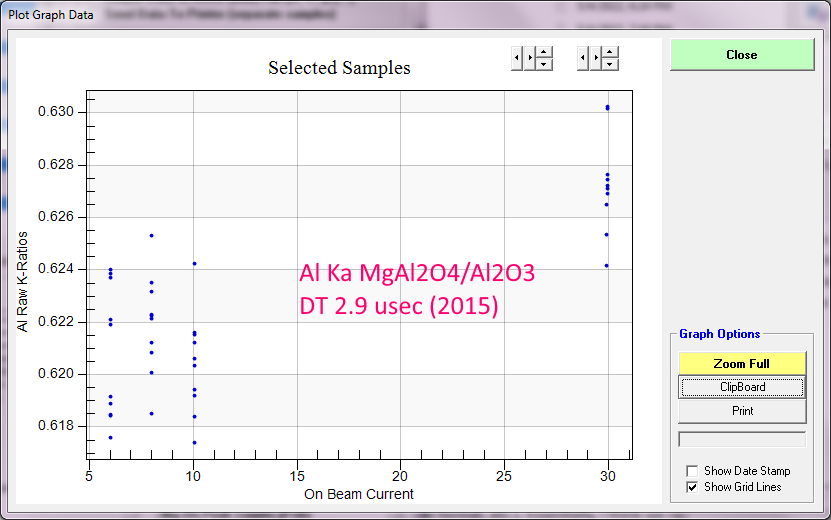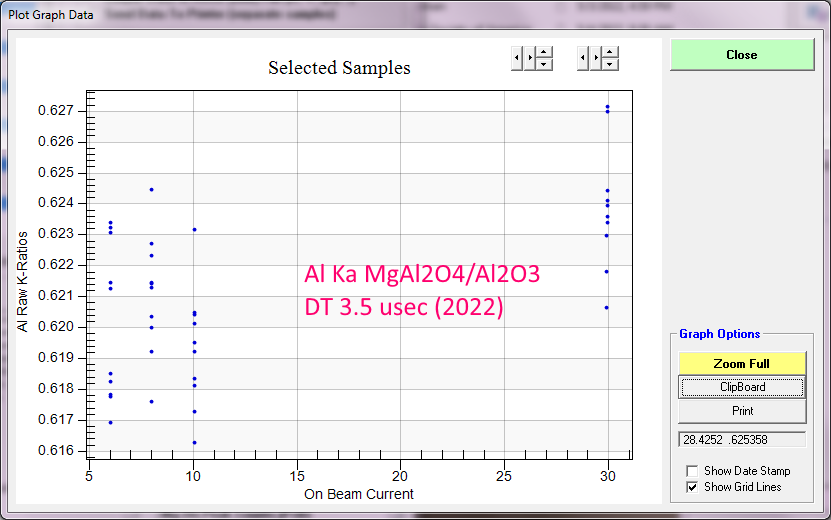John Fournelle and I were chatting a little while back discussing dead time and how to calibrate our detectors and electronics and we realized that this also depends on the linearity of our picoammeter.
Normally when performing a dead time calibration we use a single material such as Ti metal (for LiF and PET) or Si metal (for PET and TAP), because these materials will yield a high count rate and also are conductive, so hopefully less chance of sample damage and/or charging.
We then repeatedly increment the beam current and measure the count rate as a function of beam current. The idea being that without dead time effects our count rate vs. beam current should be exactly proportional, that is a doubling of beam current should produce a doubling of count rate.
But because of the dead time characteristics of all detection systems (the interval during which the detector is busy processing a photon pulse), the system will be unavailable for photon detection sometimes, and that unavailability is simply a probability based on the length of the system (pulse processing) dead time and the count rate.
Note that EDS systems, automatically "extend" the live time while processing photons so the dead time correction is part of the EDS hardware, while WDS systems must have the dead time correction applied in software after the measurements have been completed.
So this simple trend of count rate vs. beam current is utilized to calibrate our WDS spectrometers. However John Fournelle and I realized that if the picoammeter response is not accurate, the resulting dead time calibration will also not be accurate.
Even more to the point, what exactly is it we are doing with our microprobe instruments? We are simply measuring k-ratios. That is all we do. Everything else we do after that is physics modeling. The electron microprobe is a k-ratio machine, so perhaps that should be our focus. And that is exactly the point of the "consensus k-ratio" project as originally suggested by Nicholas Ritchie:
https://probesoftware.com/smf/index.php?topic=1239.0If we cannot accurately compare our k-ratio measurements to the k-ratio measurements from another lab, we do not have a science. See the consensus k-ratio project topic:
https://probesoftware.com/smf/index.php?topic=1442.0That is to say, using the same *two* materials (in order to obtain a k-ratio), and at a given detector takeoff angle and electron beam energy, we should obtain the same k-ratio, not only on all of our spectrometers, but also on all instruments. See topic on simultaneous k-ratios:
https://probesoftware.com/smf/index.php?topic=369.msg1948#msg1948Now, if are in agreement so far, let's ask another question: at a given takeoff angle and electron beam energy, and two materials containing the same element (and no beam damage/sample charging!), should the instrument (ideally) produce the same k-ratio at all beam currents?
John Fournelle and I believe the answer to this question is "yes". Now if the two materials have significantly different concentrations of an element, the count rates on these two materials will be significantly different, and therefore the dead time calibration (and picoammeter!) accuracy are critical in order to obtain accurate (the same) k-ratios at different beam currents.
So first we looked at the k-ratio measurements from the MgO, Al2O3, MgAl2O4 round robin organized by Will Nachlas, where I measured only a few different beam currents starting at 30 nA but and then at lower beam current to reduce the effects of any mis-calibration of the dead time constants. Note: these are just the first thing we looked at, as these measurements are by no means enough data, we need many more measurements and at higher beam currents!
Here are two results, the first using the original dead time calibration from 2015:

where one can see that the higher beam current measurement yield a larger k-ratio. This (positive slope) "trend" should mean that the dead time constant is too small. And now using the new dead time calibration from this year on the same data again:

So the slope has decreased as expected, but the dead time constant may still need to be increased. How can this be? Well maybe the picoammeter is not accurate... we need better (and more) measurements!